Large-scale food-scrap composting in Madison challenged by technology, logistics
The University of Wisconsin and the city of Madison have struggled to turn tons of cast-off food into soil — three local companies are trying to fill some of the gap.
Wisconsin Watch
October 17, 2022 • South Central Region
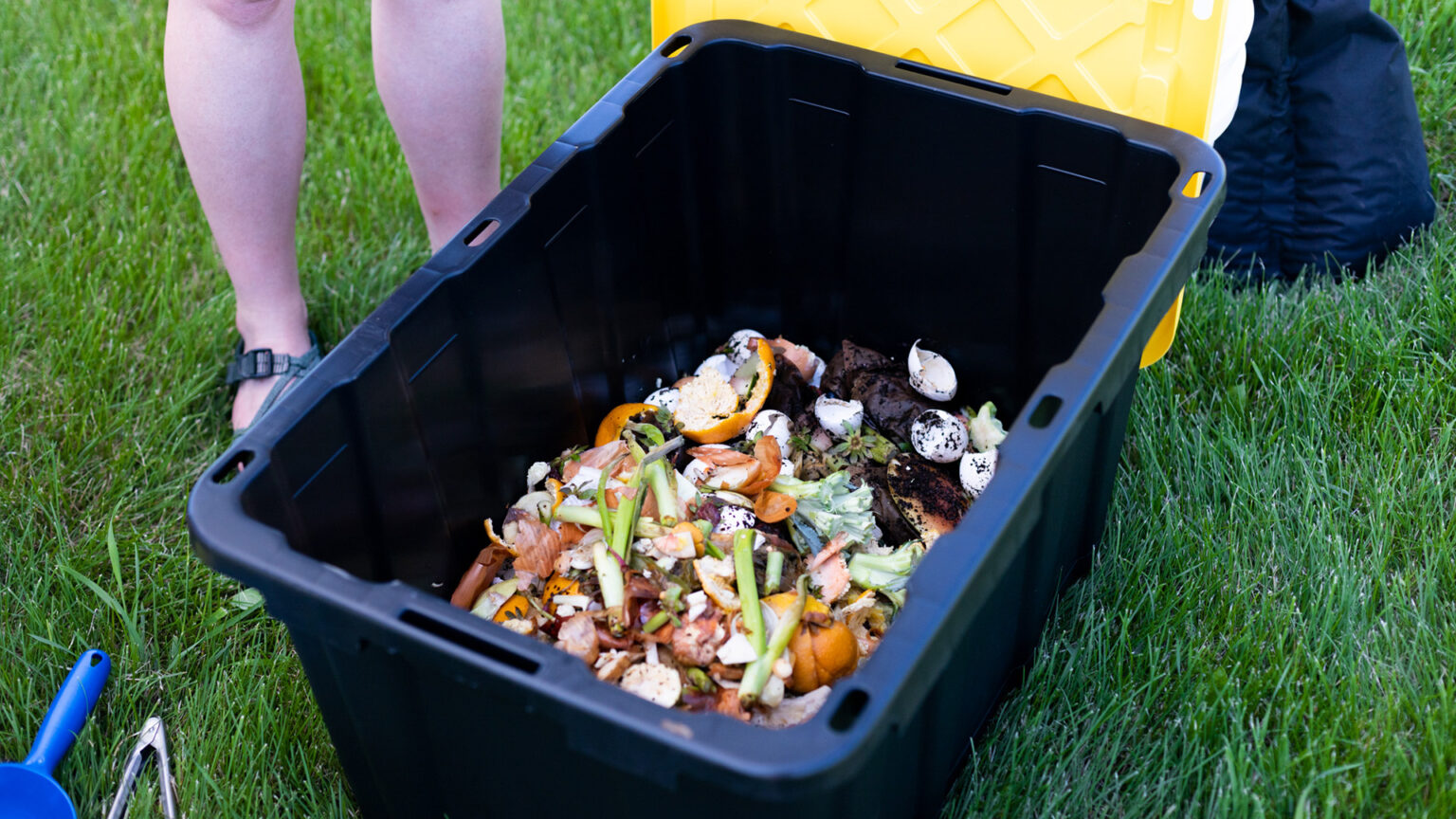
Food scraps are collected at the South Madison Farmers' Market on June 14, 2022 in Madison. The program accepts raw fruits, vegetables, coffee grounds, grains, rice, loose tea, eggshells and gourds. The scraps go to the Neighborhood Food Solutions farm in Fitchburg, where they are composted. (Credit: Amena Saleh / Wisconsin Watch)

Until recently, the University of Wisconsin-Madison had a successful program to compost discarded food.
Starting in 2009, the university collected food scraps at campus cafeterias to send to the West Madison Agricultural Research Station for composting. In 2018, the university began bringing scraps to an anaerobic biodigester, now owned by Clean Fuel Partners LLC. There, the waste was converted into methane for fuel.
But the company changed its focus, leading it to drop its partnership with UW-Madison in 2021. Travis Blomberg, the campus resource coordinator for UW-Madison’s Office of Sustainability, said the digester stopped taking food and now only uses manure as an input. That change also scuttled the city of Madison’s attempt at citywide food scraps composting.
The state Department of Natural Resources estimates 1.2 million tons of materials a year could be diverted from landfills to composting. About three-quarters of that is food waste, the DNR says, generating methane, a harmful greenhouse gas.
The city and university are not alone in their struggles to maintain large-scale food waste composting.
Only 7% of the 1,000 largest cities in the nation have a municipal curbside compost program that accepts food waste — representing just 3% of the U.S. population, according to the environmental nonprofit GreenBlue.
By comparison, 71% of the population in Canada has access to a curbside program that processes source-separated organics, including food scraps, according to the Ontario-based Environmental Research and Education Foundation.
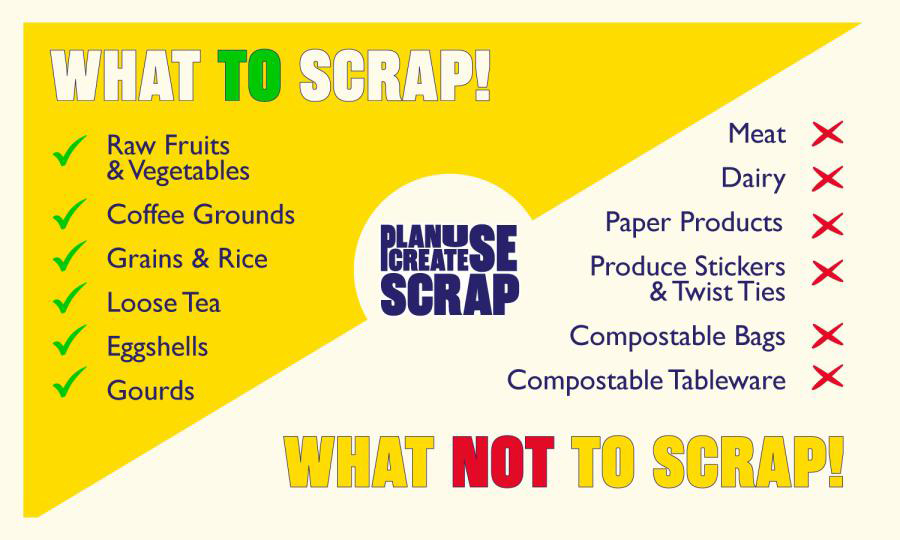
The city of Madison offers this guide to help residents decide what they can take to market food scraps sites. (Courtesy of the city of Madison)
One waste management expert described it as a “Catch-22” for Wisconsin.
“We need people to divert material to create enough business for facilities that want to compost and then have enough end markets for those. And they all need to happen simultaneously,” said Casey Lamensky, the DNR’s solid waste coordinator. “And we’re still early enough that if one of those options falls through, there aren’t a lot of backup solutions.”
Cut off by contamination
Before it was ultimately forced to shut down, UW-Madison’s composting program went through a series of setbacks including contamination of its waste stream.
At the West Madison Agricultural Research Station, the facility’s system churns and aerates organic waste in long rows to produce compost. But it struggled to process non-compostable materials — such as plastic bags, packaging and metal — in the food streams coming from the university, Blomberg said.
The university attempted to “clean the stream” of its food waste, recruiting students to conduct trash audits in campus cafeterias and training staff to sort food waste and run it through a pulper machine.
Still, the waste from campus-caused problems — paper containers and napkins slowed down the system, and lightweight objects blew away. The agricultural station also had to make expensive repairs to tractor tires pierced by metal silverware tossed into compost bins.
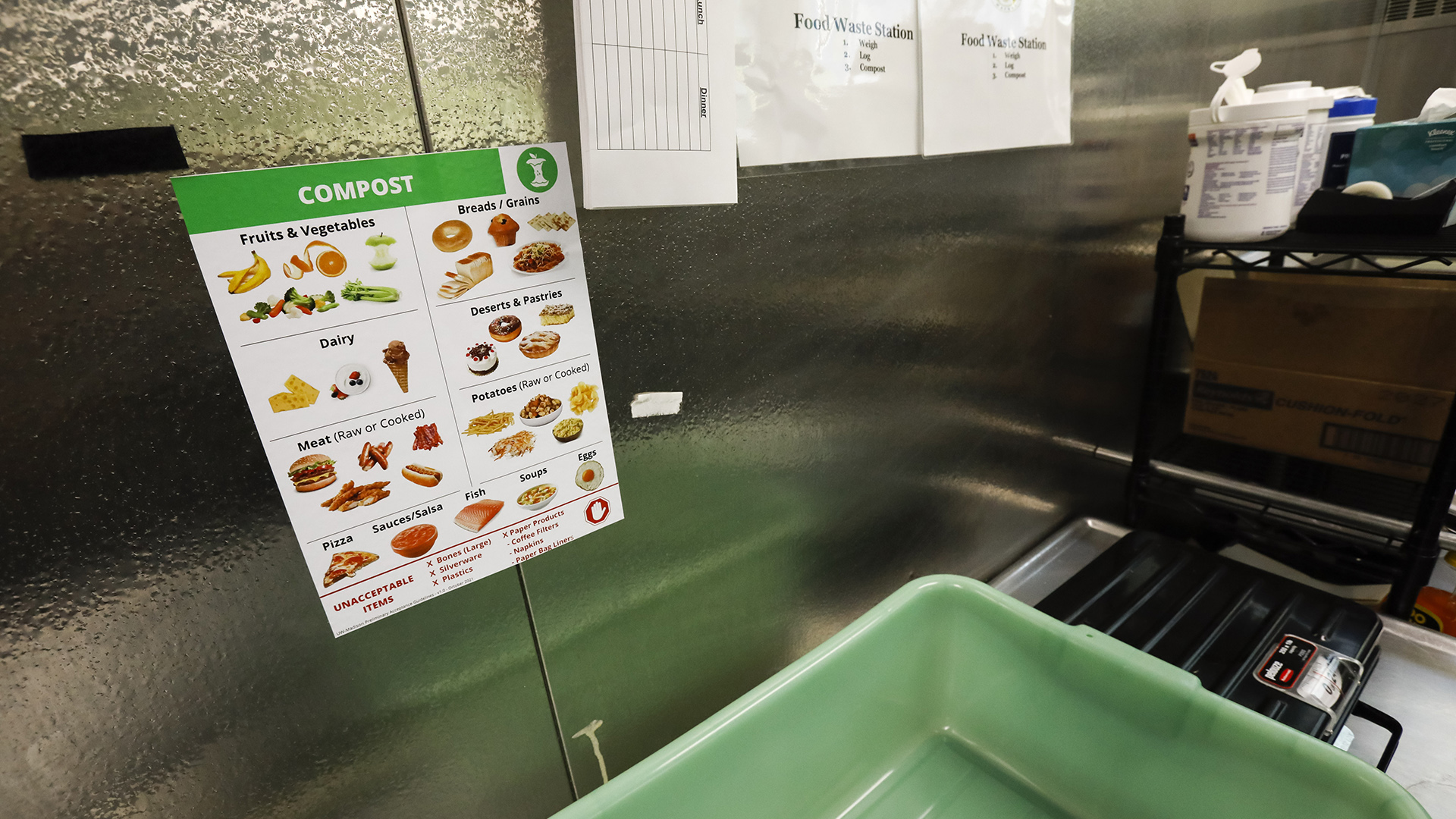
Compost bins and instructions are available for cooks in the kitchens of Gordon Dining and Event Center at the University of Wisconsin-Madison. The university formerly ran a large-scale composting program, but that was scuttled after the biodigester that turned food scraps into methane changed to only accepting cow manure. (Credit: Ruthie Hauge / Cap Times)
The contamination was in the “front of the house” materials, food scraps thrown away by cafeteria customers, Blomberg said. Contamination of non-compostable items is “always an issue” with food waste collection, he said, adding “the program wasn’t perfect.”
So when an opportunity arose in 2018 to move the university’s compost program to an anaerobic digester — which separates food from contaminants with a depacker machine — Blomberg said the university signed on until the digester’s operators stopped accepting food scraps in July 2021.
“We can do everything in our power, but we don’t have an industrial composter near us that (wants) the material,” Blomberg said.
Municipal composting falters
Like UW-Madison, the city of Madison has led several food composting initiatives — all of which proved to be ill-fated.
The most recent program scrapped by the city allowed residents to drop off their food scraps at three different locations. The material was then sent to a biodigester that extracted methane from the waste. That program came to an end after the biodigester began extracting methane exclusively from cow manure — the same change that ended UW-Madison’s program, according to the city’s recycling coordinator Bryan Johnson.
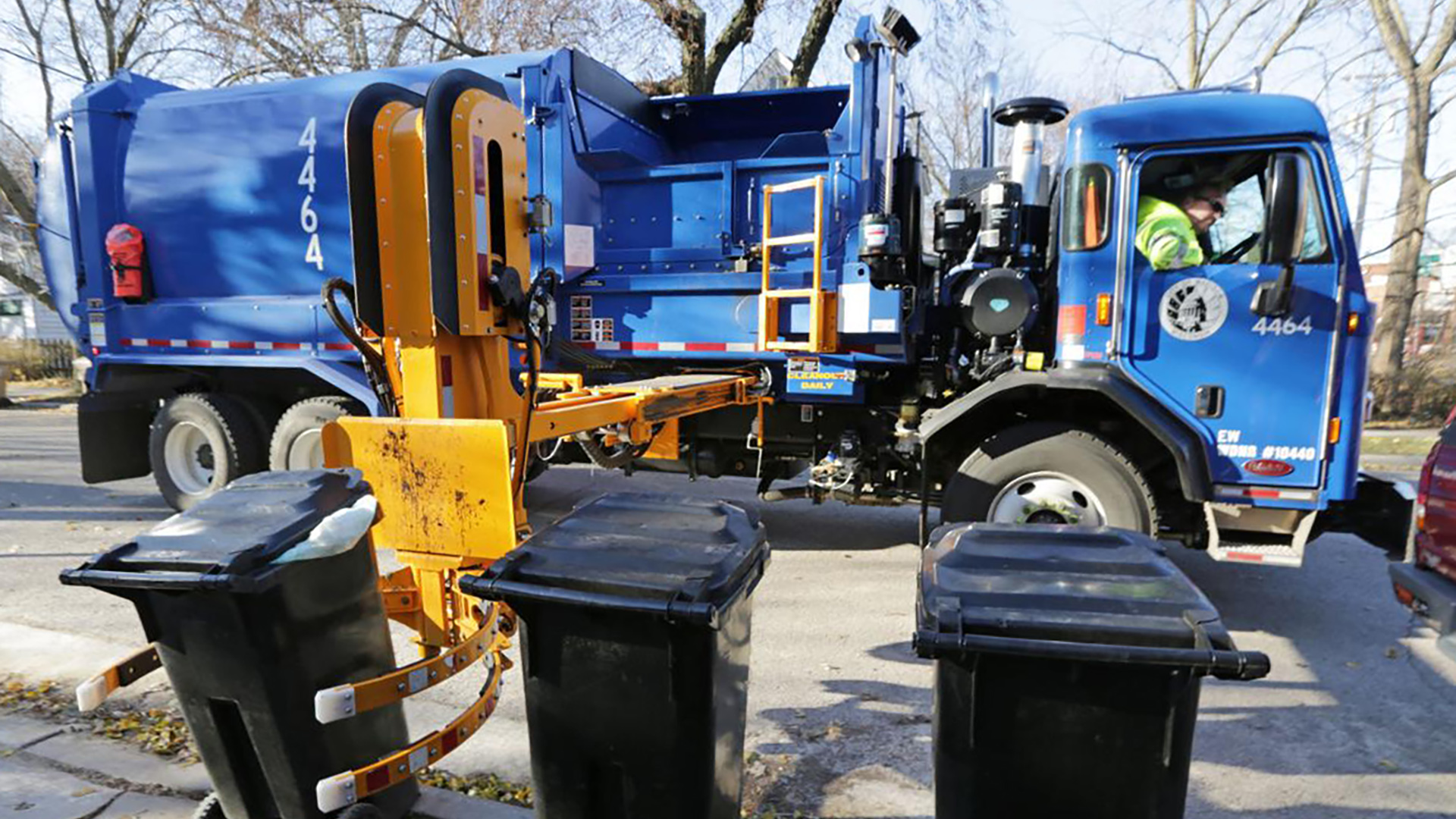
A city of Madison truck empties three compost bins outside the Harmony Bar & Grill on the city’s east side in 2017 during a pilot food scrap diversion program. The city ended food scrap recycling in 2021 after the digester that had been accepting the scraps switched to accept only manure to generate methane gas. (Credit: Amber Arnold / Wisconsin State Journal)
The city previously attempted two curbside composting programs, but the efforts failed because it was too labor intensive — and the food scraps were often contaminated. Coat hangers, towels, children’s toys — and even a deer head — were among the items that caused contamination, Johnson said.
But Madison is giving food scraps recycling another go. Thanks to a grant from the U.S. Department of Agriculture, the city opened two food scraps drop-off sites at farmers’ markets this summer, which go to the Neighborhood Food Solutions farm in Fitchburg for composting. The sites at the South Madison and East Side farmers’ markets will operate until Oct. 25.
While the operation is “super small,” Johnson said he hopes to expand the number of sites. So far, the two-site initiative has collected close to 8,000 pounds of food scraps. It’s not much but, he said, every ton of compost is “a win.”
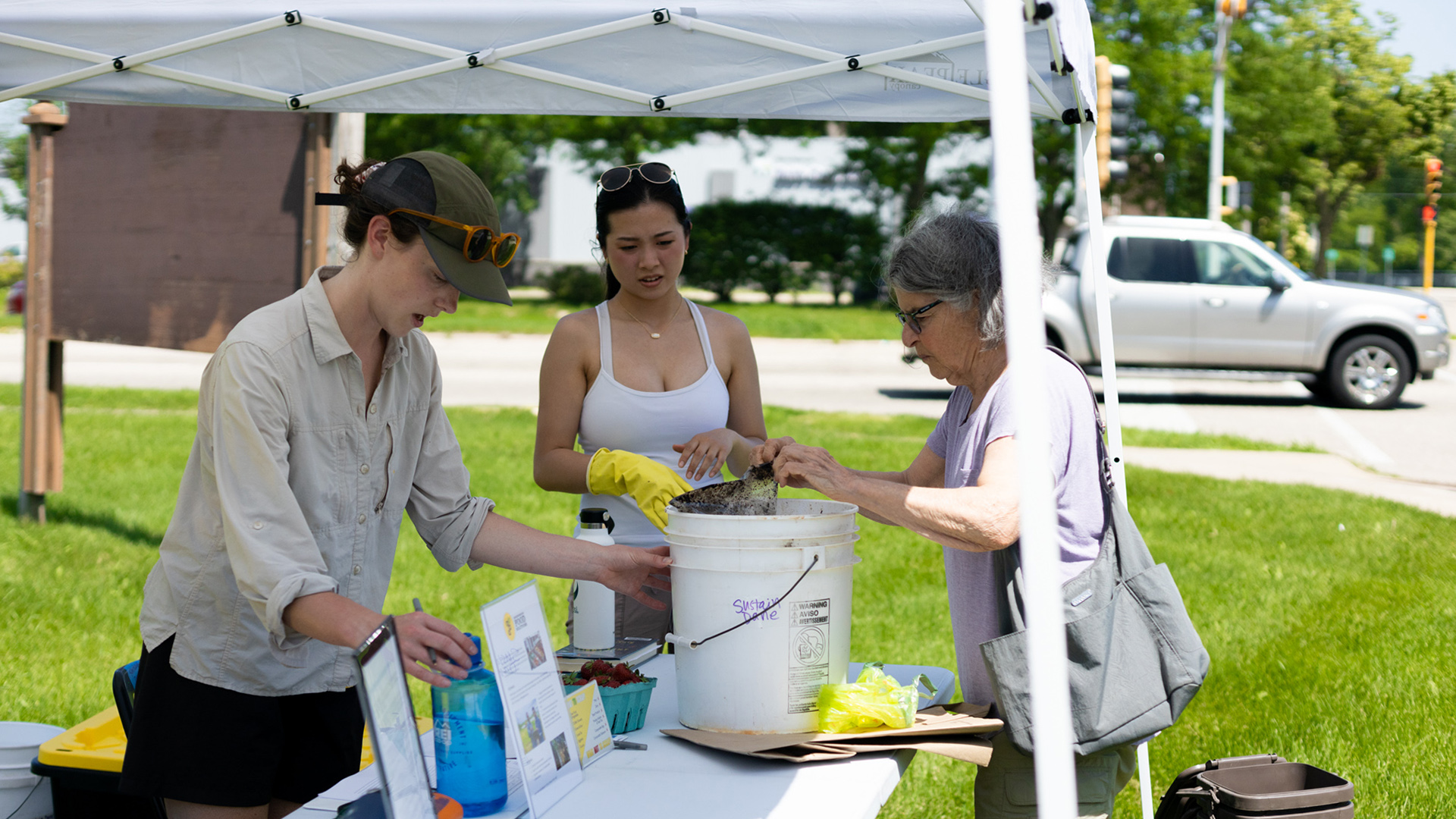
Lucia Hunt, the development and partnerships manager at Sustain Dane, left, and Daphne Joyce Wu, an intern with the group, center, collect food scraps from a participant at the South Madison Farmers’ Market on June 14, 2022 in Madison. (Credit: Amena Saleh / Wisconsin Watch)
In the long-term, the city hopes to work with Dane County’s Sustainability Campus – a proposed landfill and waste disposal project slated for the Yahara Hills Golf Course – to house a large-scale program.
“From all the pitfalls that we’ve had along the way, it’s hard to be optimistic, but I am still optimistic about this,” Johnson said. “I know we’re going to do it — it’s taken a lot longer than I think anyone ever wanted it to.”
Minnesota ahead on composting
Minnesota has numerous municipal composting programs — including several that collect organic material curbside. The Ramsey/Washington County Recycling & Energy Center in Minnesota plans to launch curbside food scrap collection by the end of 2023. It is led by UW-Madison graduate Junalee Ly.
Residents will collect their food waste in thick compostable bags provided by the two counties, disposing of it in the same way as their normal garbage or recycling bins to be recovered at a waste processing facility for composting, Ly said.
“Our program is unique because it relies on existing collection infrastructure, and trash haulers don’t have to change anything about how they deliver their service,” she said.
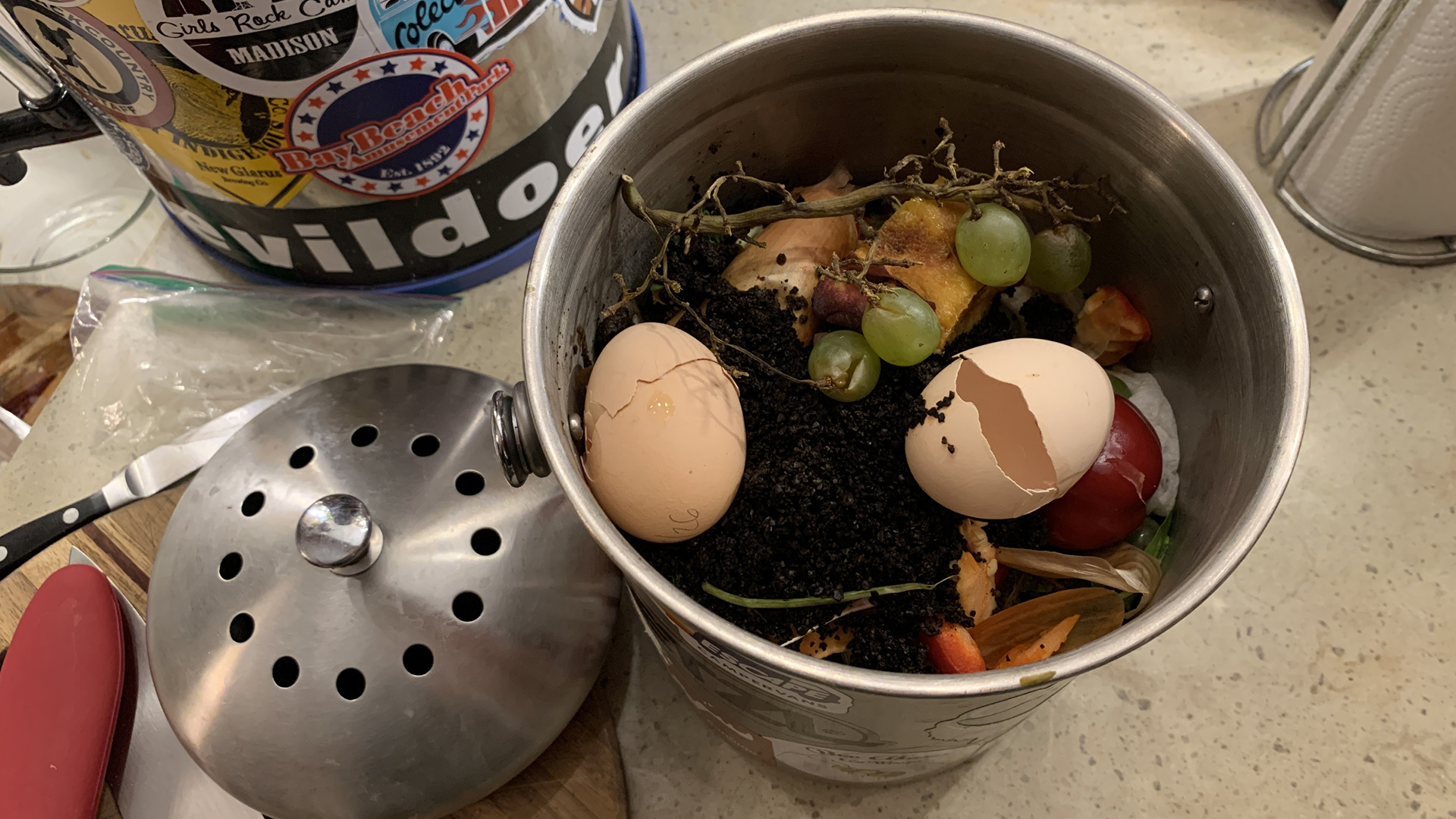
A composting pail is seen in the home of Madison resident — bound for a backyard home composter. A lack of infrastructure in Wisconsin has caused municipal programs like Madison’s efforts to start up, only to later stall. (Credit: Coburn Dukehart / Wisconsin Watch)
Lamensky, the DNR solid waste coordinator, said food scraps collection programs are more common in larger, densely populated cities, especially on the coasts. In these areas, which have limited land area, the cost of landfills can be more expensive than composting.
One bright spot in Wisconsin: Yard waste composting. A landfill ban on yard waste implemented in the state in the 1990s has resulted in more than 200 municipal composting programs, turning an estimated 200,000 tons a year of leaves, grass clippings and small pieces of brush into compost, which is generally given away for free. Ironically, that makes food waste composting a tougher business endeavor in the state.
“(Food waste compost) is usually a more profitable product, but it is hard to make a case for buying (food scraps) compost — even if it’s a higher quality compost — in the state when there’s a bunch of yard waste compost available for free,” she said.
A lack of infrastructure in Wisconsin also causes municipal programs like Madison’s efforts to start up only to later stall. The on-again, off-again efforts to compost food may leave residents confused, increasing the chance of contaminating the recycling waste stream, Lamensky said. Her advice: If in doubt, throw it out.
Subscription services dominate
Although Madison has failed to sustain a citywide composting program, there are private companies that turn food scraps into soil — for a price.
At least three services — Curbside Composter, Earth Stew and Green Box Compost — are available in the Madison area. Ben Stanger, founder and CEO of Green Box, started his company earlier this year to fill what he saw as a growing need in the area. Green Box charges members $24 a month.
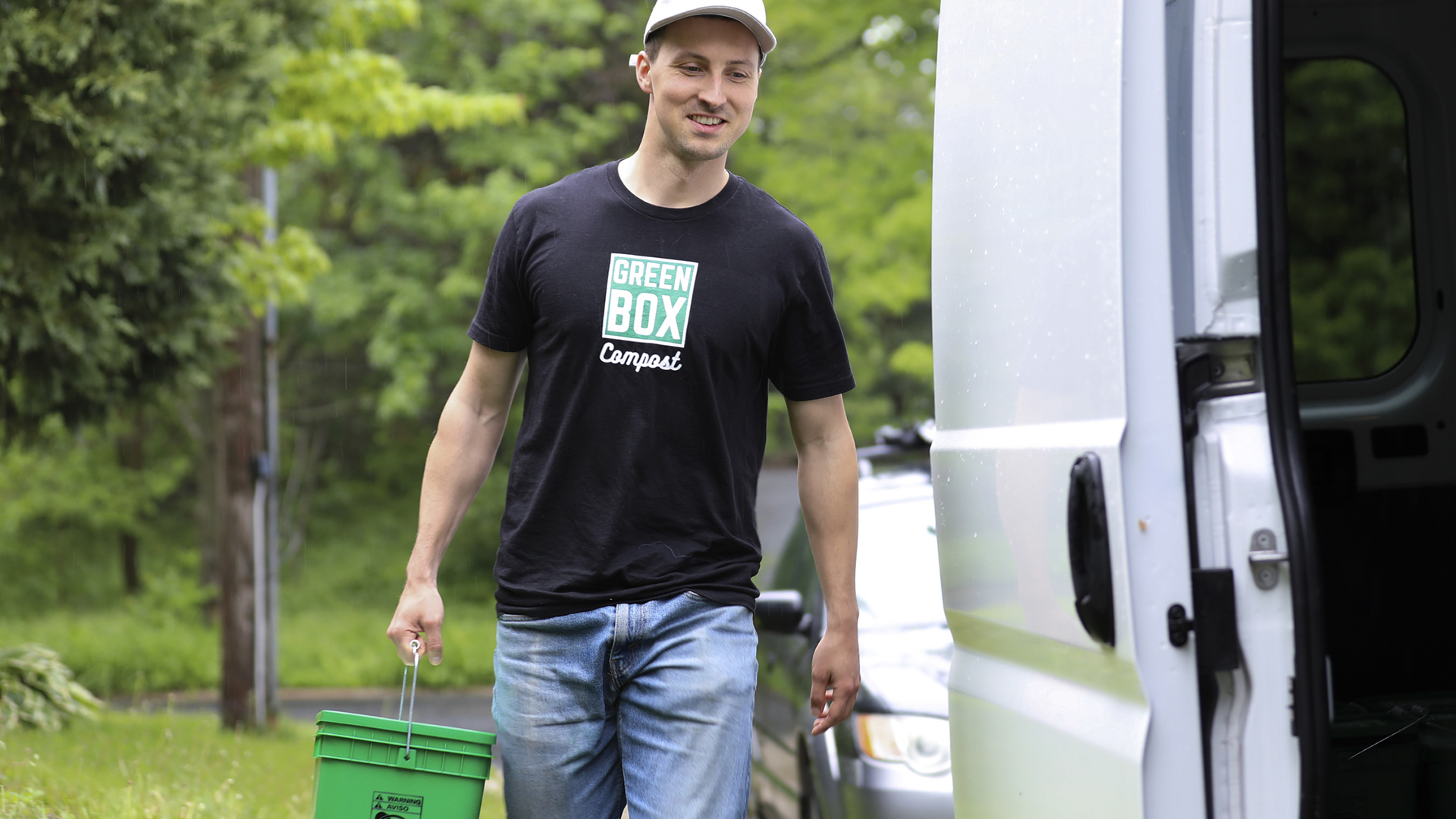
Ben Stanger, founder and CEO of Green Box Compost, picks up buckets of food scraps from a client’s home in Madison on May 25, 2022. Green Box Compost charges Madison subscribers $24 a month for a single-bucket pickup every other week or $34 for a two-bucket pickup. (Credit: Coburn Dukehart / Wisconsin Watch)
“There’s a lot of young people who I think have sustainability (as a goal) generally, but also food and food waste more particularly as something that they want to focus on,” Stanger said. “And I’d like to offer this to them in a way that is convenient and easy and cheap.”
Lamensky said subscription-based services like Green Box continue to outnumber municipal programs in the state because private companies can “move more nimbly,” bypassing bureaucracy that can slow down implementation.
The DNR tries to help by offering technical support to Wisconsin municipalities and waiving reviews and standard licensing fees to encourage start-up programs, she said.
Some states and municipalities have state laws that incentivize diverting food scraps from landfills. Minnesota has a statutory goal of recycling 75% of its waste by 2030. Wisconsin does not have a required benchmark, but the DNR has a goal to reduce food waste by 50% by 2030.
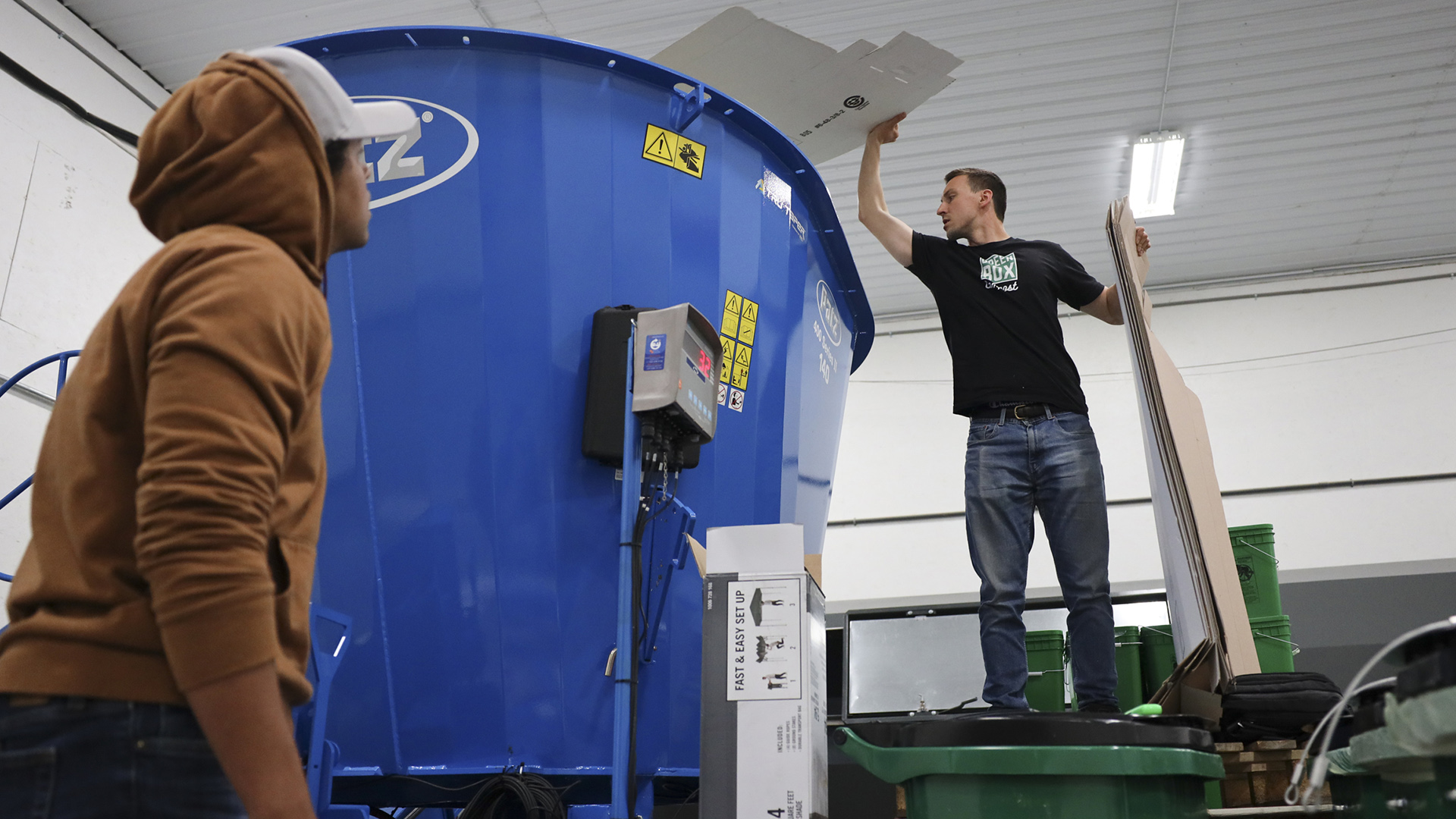
Esai Ponce, Green Box Compost marketing manager, left, and Ben Stanger, the company’s founder and CEO, work at the company’s warehouse in Sun Prairie on May 25, 2022. About 100 residents and two restaurants are subscribed to the Green Box Compost service that picks up their organic waste. Subscribers can compost any food waste including bread, meat, and dairy. (Credit: Coburn Dukehart / Wisconsin Watch)
Despite the challenges, Lamensky is hopeful that more municipalities will give it a try.
“And when we have more examples here in Wisconsin, I’m hoping that other municipalities will see it being done effectively and also be ready to follow that lead,” she said.
Tackling waste at its source
UW-Madison is examining different options to bring composting back to campus through a pilot program with the Agricultural Research Station. Unlike the previous arrangement, Blomberg said material is restricted to “back of the house” food scraps from the university’s four largest food waste generators — making up more than half of all food waste on campus.
But the pilot program is only a temporary solution, and the university’s proposals to vendors to find a long-term composting facility have been unsuccessful so far, Blomberg said.
The university also is searching for other ways to cut food waste. For example, a team of students secured money for food waste reduction technology through the Green Fund — an initiative that funds student-led projects tackling environmental challenges on the UW-Madison campus.
The project places digital scanners in trash bins to analyze what food is being tossed so the university can adjust its food purchases.
“It’s easy, simple, cost-effective solutions that will not only save the university a lot of money, but that it will save some of that issue of waste being made and put into landfills,” said Jacob Breit, a senior working on the project.
Blomberg agreed that minimizing waste is the best and easiest solution.
“The bigger question,” he said, “is why are we producing so much food waste in the first place? And that’s a valid question.”
Wisconsin Watch reporting intern Erin Gretzinger contributed to this report. The nonprofit Wisconsin Watch collaborates with WPR, PBS Wisconsin, other news media and the University of Wisconsin-Madison School of Journalism and Mass Communication. All works created, published, posted or disseminated by Wisconsin Watch do not necessarily reflect the views or opinions of UW-Madison or any of its affiliates.
 Passport
Passport





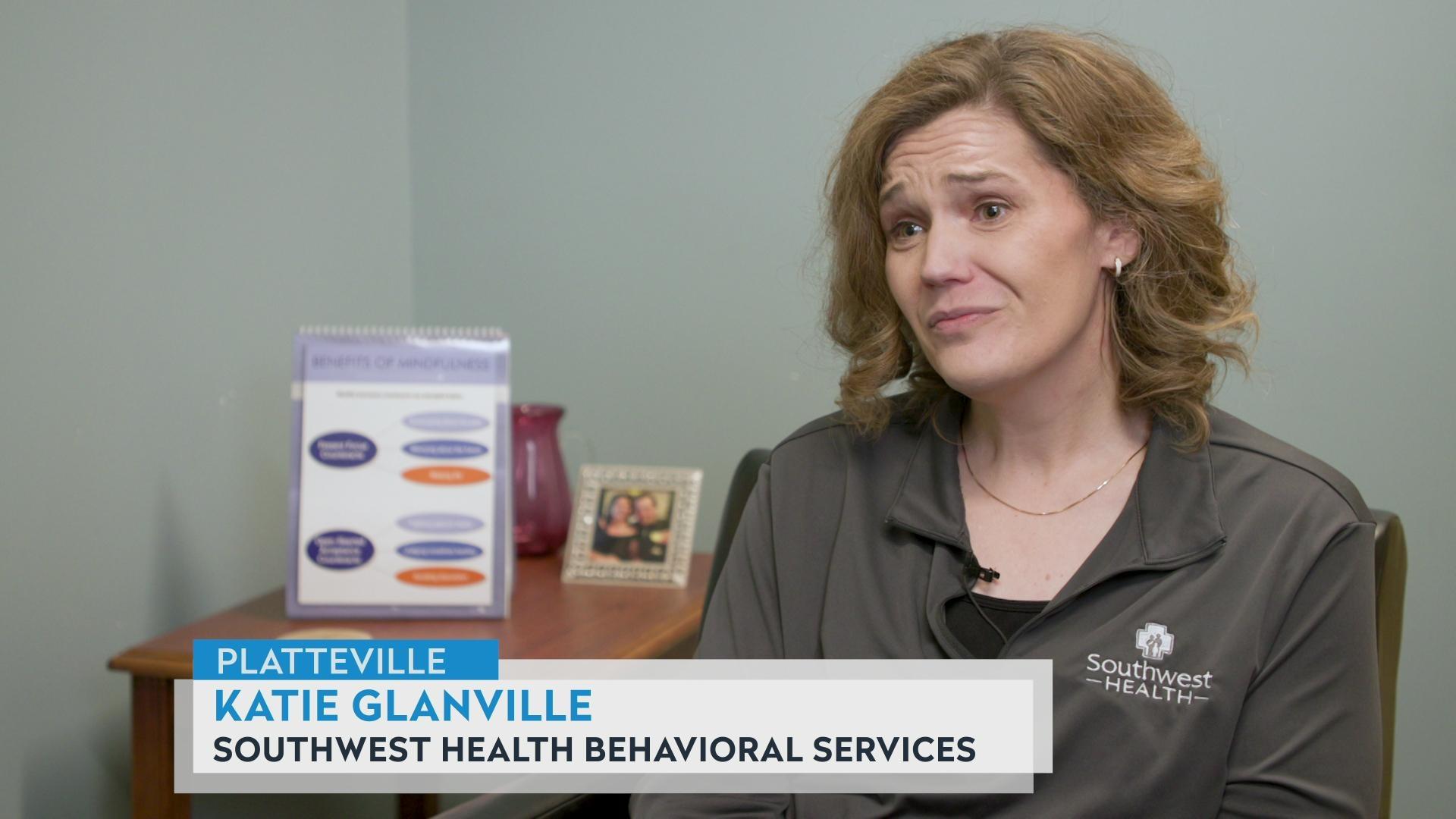
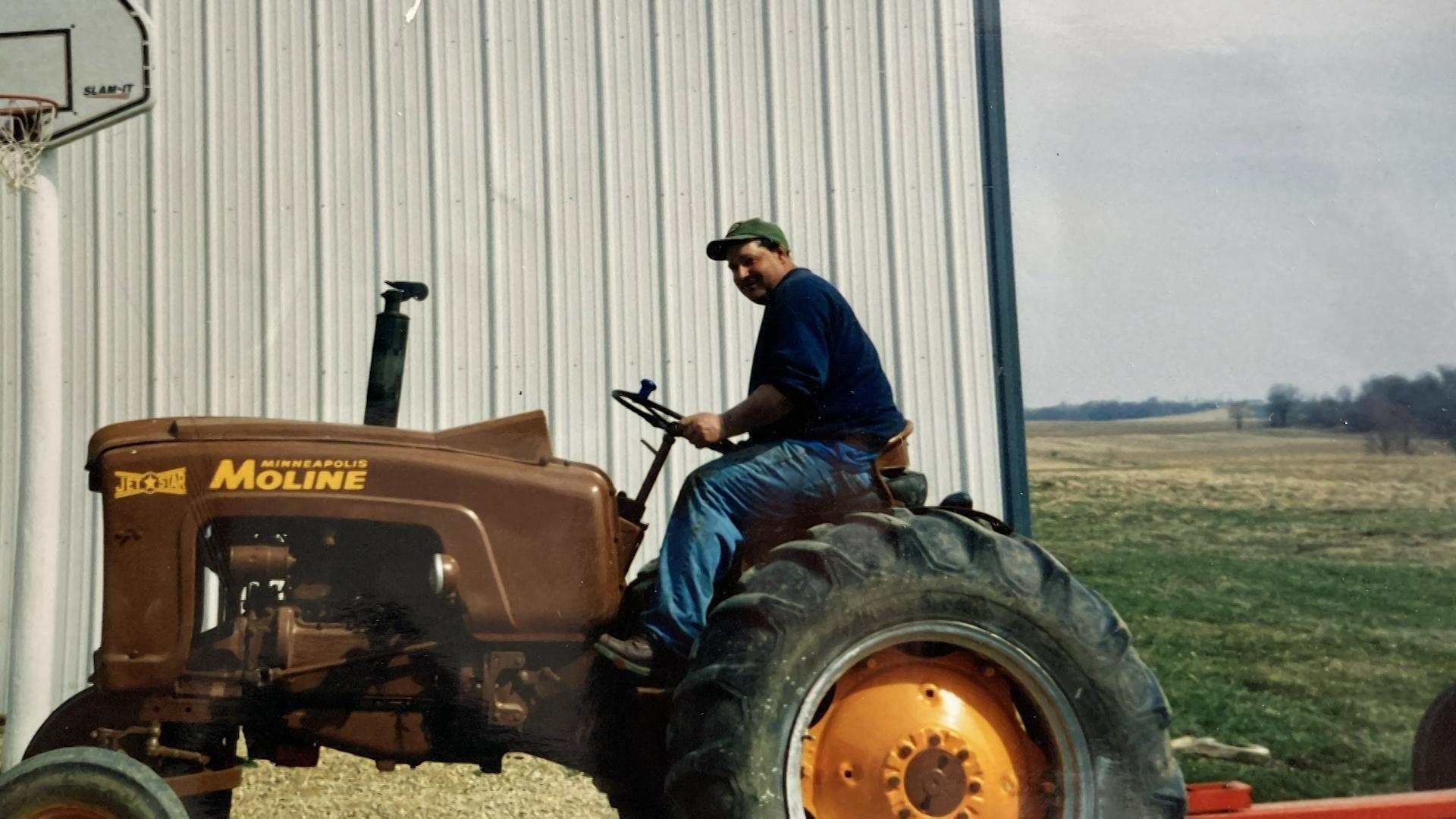
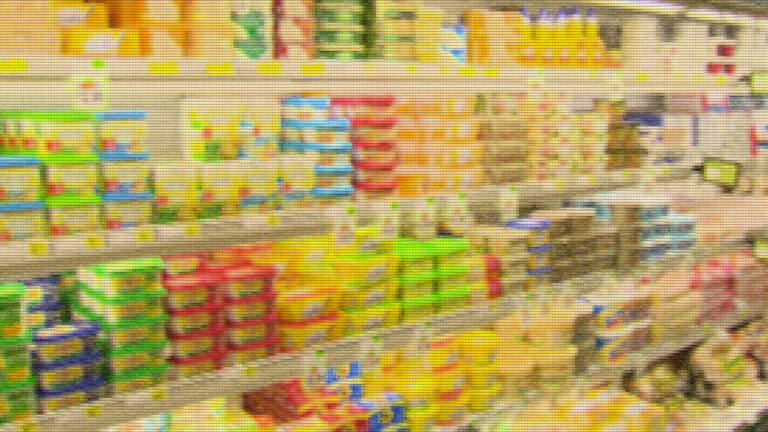
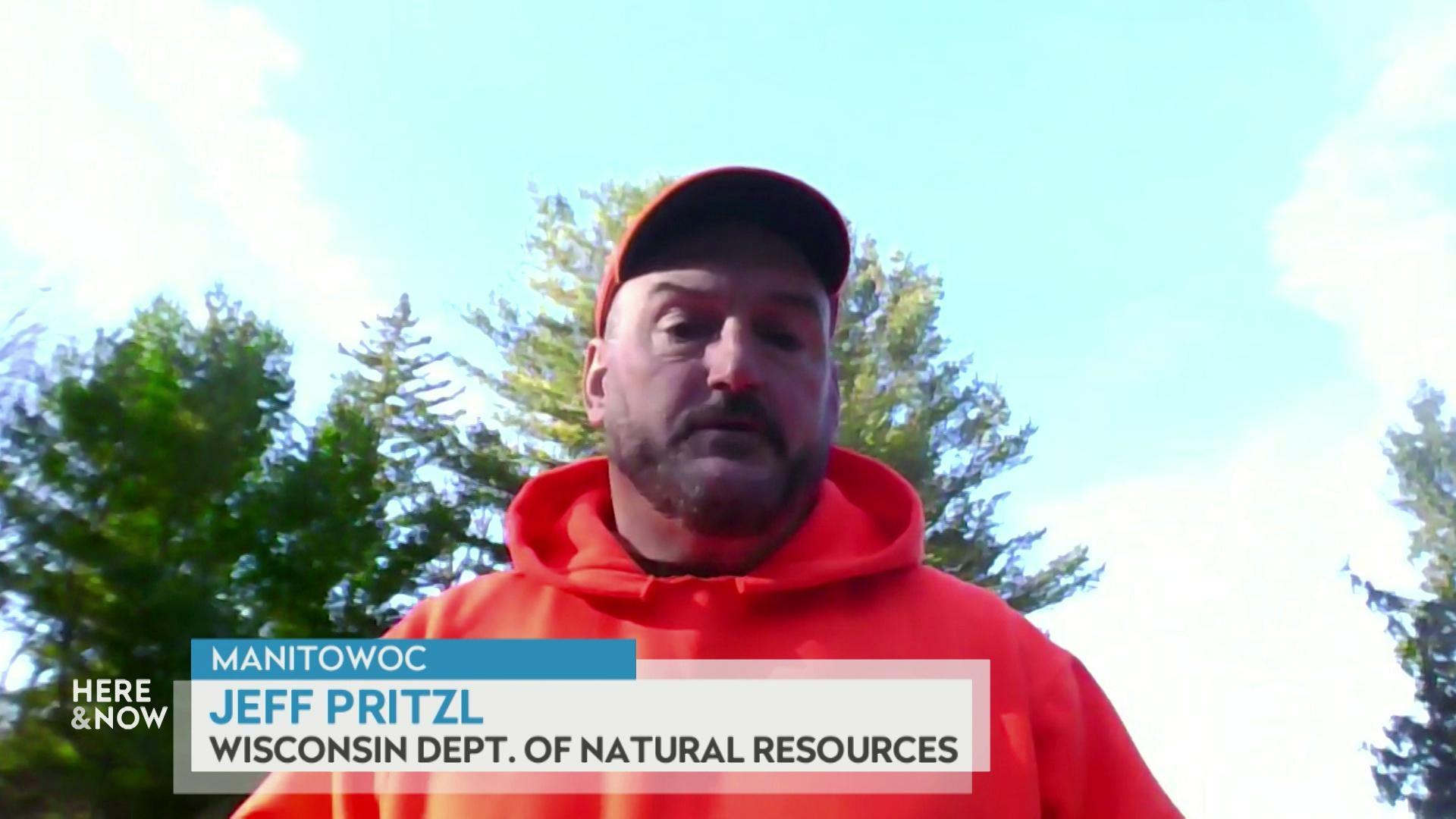
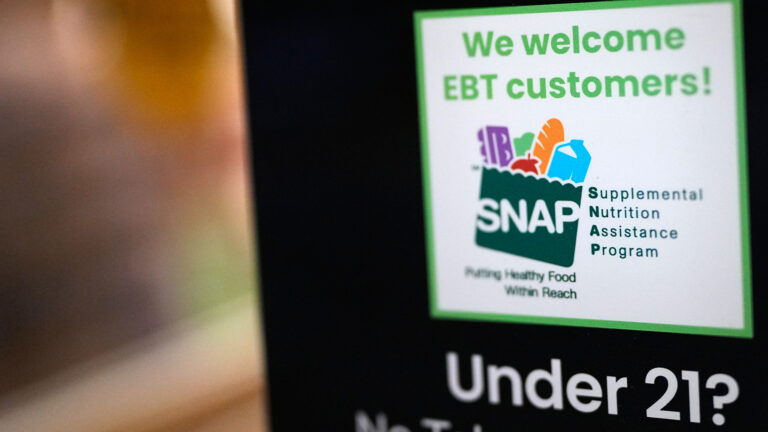

Follow Us